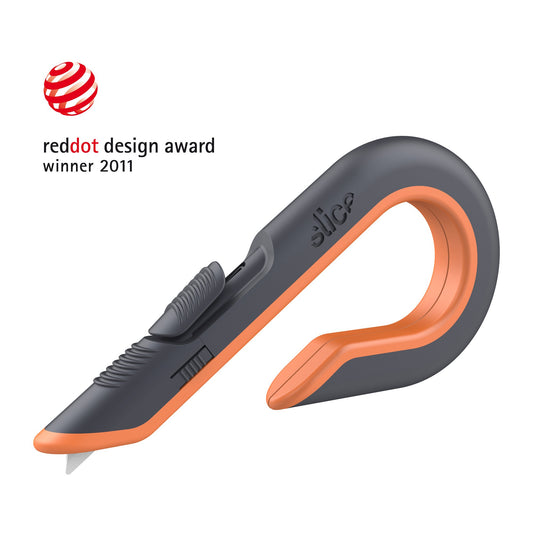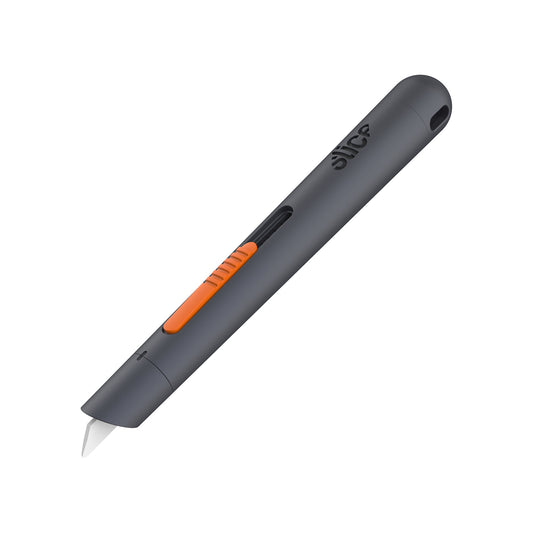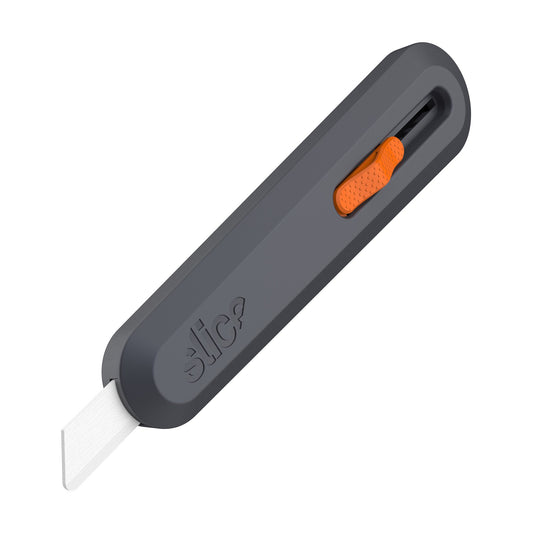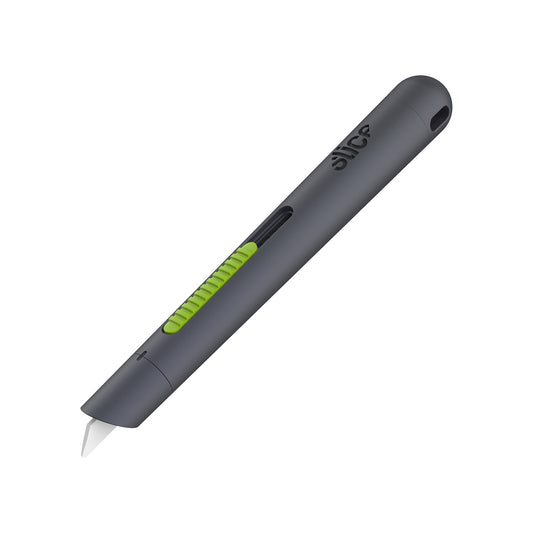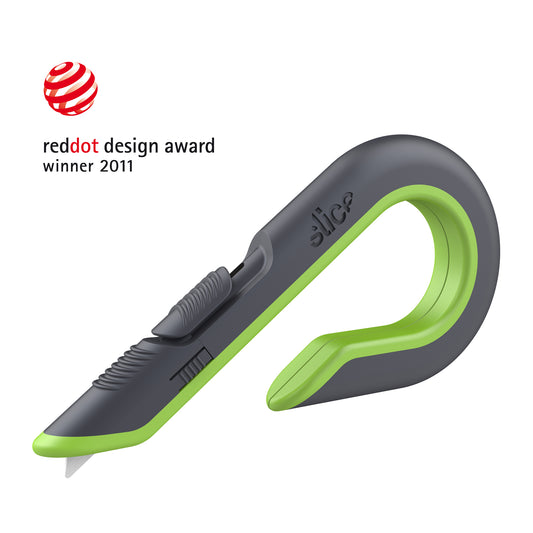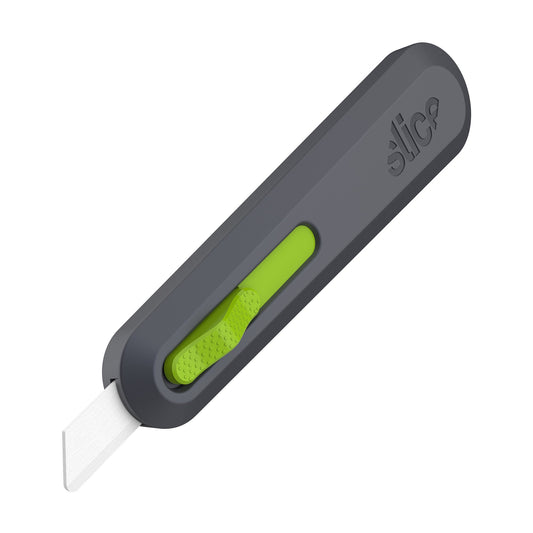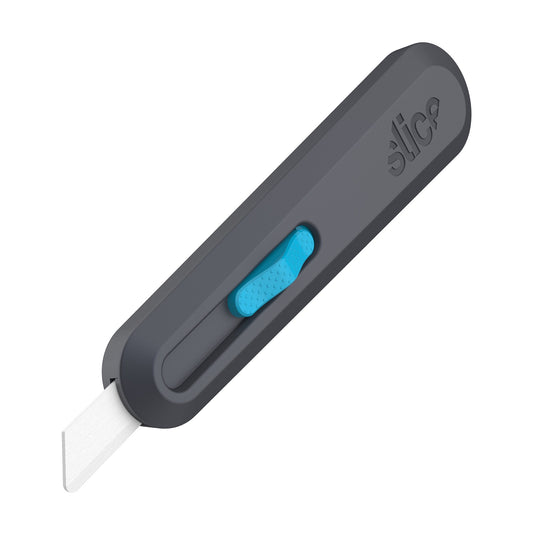Retractable Knives: Know Your Handles

The first retractable knives were developed in the early 1950s. As the benefits of this safety innovation made it more popular, every knife manufacturer created its own version. Retractable utility knives are now so common, you’d be hard pressed to find someone who hasn’t used one at home or in their workplace. And while most people understand “retractable” to mean a spring-loaded mechanism that exposes the blade only while a slider or button is held, there are actually several different types of retraction mechanisms. Here’s a rundown of each kind, with its benefits and drawbacks, and some advice about choosing the best safety knife for the job.
Manual Retraction Handles
Most people don’t think of this style of handle as “retractable” because its mechanism is manual rather than automatic but, strictly speaking, this type of knife belongs on the list of retractable utility knives simply because its blade retracts into its handle. Rather than extracting the blade along a continuum controlled by the user, however, these blades have preset (or fixed) positions, where the blade locks for cutting.
Although these fixed positions allow the user less control when it comes to choosing a specific blade depth, they doremove some potential hand strain because once the blade position is set, the user doesn’t have to engage any mechanism to keep the edge exposed. When you’re performing repetitive cuts over time, this adds significantly to your comfort.
The downside of set blade positions really has to do with human nature. When it comes to fully retracting the blade for safety’s sake, users often forget. A knife with an exposed blade is a danger as soon as it gets put in a pocket, picked up absent-mindedly by the next user, or knocked on the floor and forgotten.
Takeaways about manual retraction:
- Reduces hand strain compared with other retraction methods
- May become dangerous if users forget to fully retract the blade after use
- Poses a risk if the knife slips while the user is cutting
- Best for repeated cutting over long periods of time
- Look for handles that feature multiple blade positions, including the smallest cutting depth possible for your task
Slice manual retraction options:
- 10400 Manual Box Cutter
- 10513 Manual Pen Cutter
- 10550 Manual Utility Knife
Automatic Retractable Knives
An automatic retraction mechanism is the one that comes to mind first when people think of auto-retractable knives. This is the standard kind of spring-loaded retraction that requires the user to engage a slider or button (sometimes called a trigger) to expose the blade and make the cut.
This kind of handle is inherently safer than a manual-retract knife simply because the user cannot accidentally leave the blade exposed. Safety managers love this option for obvious reasons: no blades left accidentally exposed, which means these knives can be safely carried in pockets. Users are able to better control the length of blade exposure, and therefore the depth of the cut. Automatic retraction tends to cost slightly more because it’s more expensive to manufacture, but this cost difference pales in comparison to the cost of an injury.
Takeaways about automatic retraction:
- Increases safety by removing the possibility of accidental blade exposure
- Requires more effort to keep the blade exposed during long cutting shifts
- Users can bypass the auto-retraction by taping the slider in position so the blade is always exposed, thus negating any safety gains
- Best for reducing injuries due to blades left exposed when not in use
- Look for ergonomic handle styles to reduce hand strain
Slice automatic retraction options:
- 10503 Auto-Retractable Box Cutter
- 10512 Auto-Retractable Pen Cutter
- 10554 Auto-Retractable Utility Knife
- 10514 Auto-Retractable Mini Cutter
Self-Retracting or Smart-Retracting Handles
These retractable-blade knives take safety to a new level, and really are the safest option in terms of retraction methods. These tools require both a user to engage the blade and the pressure of the blade dragging against material to expose the blade. In practice, this means that the blade retracts as soon as it loses contact with the cutting material, even if the user is still engaging the trigger. This protects against accidental lacerations that occur when the user’s hand slips while making a cut. It also makes it impossible for users to bypass the retraction by simply taping the slider into position.
Self-retracting handles are more expensive because it’s more expensive to manufacture the internal smart-retracting mechanism. But when a single laceration can cost tens of thousands of dollars, the investment is often worth it. These handles also take a bit of getting used to in order to find the right tension required to keep the blade exposed, but users who are comfortable with auto-retracting knives will adapt quickly.
Takeaways about self retraction:
- Offers the safest blade exposure option on the market
- Initially takes some getting used to
- Requires muscle effort to re-engage the blade after each cut
- Best for reducing injuries due to blades left exposed when not in use AND accidents from slipping during a cut
- Look for a spring mechanism with a tension that suits the material you’re cutting so it doesn’t self-retract too easily or not at all
Slice smart retraction options:
What About Non-Retracting Knives?
Knives with blades that don’t retract exist too, and they have their place. If safety is your primary concern, you generally want some kind of retraction. The exception is when you can use one of Slice’s finger-friendly® blades.
Non-retracting knives fall into a few categories.
Embedded Blades
This includes any fixed blade that is embedded in the handle itself. Some of these have replaceable blades, but truly embedded utility knife blades are embedded in the handle material so isn’t replaceable. If these blades are metal, they dull quickly and will need to be sharpened often. Slice offers several precision cutting tools with replaceable or embedded finger-friendly blades (all come with safety caps).
From a safety standpoint, embedded blades not particularly safe because the blade is always exposed, though some models mitigate this with a cap or sheath. Slice’s micro-ceramic blades are an exception, safety-wise, because they’re finger friendly and too small to cause deep lacerations in skin. These tiny blades are featured on our popular Safety Cutter and Precision Cutter tools.
Folding Handles
These knives have hinges so their blades fold into the handle itself, like a typical pocket knife or Swiss army knife. This provides a fixed-position blade while you’re cutting and a built-in blade guard for when the knife is not in use.
Which Retractable Utility Knives Will Work For You?
As with many tools, it really depends on your particular application, the emphasis you wish to place on safety, and to some degree, personal preference. With the information in this guide, you should have some ideas about what factors to consider. Don’t be afraid to try several different retractable knives to find your best fit; the right utility knife is well worth the research.
Further Reading:
- Learn why Slice retractable knife blades are safer than metal or overly-sharp ceramic blades.
- Find out how to spice up your workplace safety training to implement new tools.
- Discover why Slice ceramic blades are different from other ceramics on the market.

